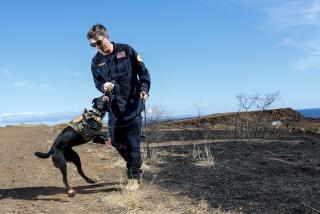Police Dog Trained to Sniff Out Cancer
- Share via
TALLAHASSEE, Fla. — The dermatologist and the dog trainer watched as George the award-winning schnauzer circled a patient, sniffing until he came to a suspected cancerous mole.
The dog sniffed hard, then sat down. “Show me,” ordered trainer Duane Pickel. The dog lifted his paw and gently touched the spot. A lab test confirmed it was cancer.
“At least in our limited project, dogs could be trained to scent and detect melanoma,” Dr. Armand Cognetta, a dermatologist who specializes in skin cancer, told the Tallahassee Democrat.
Cognetta and Pickel, a retired officer from a police K-9 unit, worked two years on a pilot study that ended last fall.
Now it’s up to medical peers to review the results, said Cognetta, who questioned whether dogs are able to detect skin cancer. But he says dogs might be trained to find other cancers, or detect other diseases in Third World countries without high-tech medical equipment.
Melanoma is the deadliest skin cancer and the fastest-growing type of cancer in the country. Doctors nationwide find only about 80% of melanomas in time, and last year, 6,500 patients died.
“I literally go to sleep sometimes thinking, ‘What’s a better way?’ ” Cognetta said.
He got the dog idea after hearing an account of police using a dog to search for a body in a lake.
A search of medical journals found a four-year-old letter about a woman who asked to have a mole removed after her dog kept sniffing and biting at it. Doctors removed it and found it was cancerous.
Cognetta talked with Pickel, who has trained dogs for 33 years, including eight as a sergeant in Vietnam and 22 as head of the K-9 unit of the Tallahassee Police Department.
“A dog can be trained to find anything you need it to find,” Pickel said. “It’s the same game as drugs or bombs. I was sure we could do it.”
Pickel began training his prize-winning schnauzer to find a test-tube containing a melanoma sample. George, energetic and friendly even with strangers, is a top bomb-detection dog who obeys more than 100 hand signals and has won nearly 400 obedience awards.
His accuracy soon topped 99% on tests such as finding the cancer sample in one of 10 holes in a long box. He began training with Kim Edwards, a nurse at Tallahassee Memorial Regional Medical Center, who said she wanted to be involved because of a family history of skin cancer.
Edwards would put bandages on her body, sometimes with a cancer sample underneath. In more than 40 trials over more than a year, George reached nearly 100% accuracy in finding the right bandages.
Then Cognetta found seven patients over a 10-month period who agreed to let George search them for cancer. In each case, their doctor suspected a melanoma but the diagnosis had not been confirmed by laboratory tests.
In July 1994, George found the suspected mole on the first test patient. The dog searched six more test patients in 1995. He correctly identified cancer in at least four of the seven volunteers, and perhaps five depending on how one test is interpreted, Pickel said.
The trainer said there were explanations for the misses. Edwards bathed with non-fragrant soap and wore a bathing suit for training. With the seven suspected melanoma patients, other odors--from clothes, perfume, coffee or food--were present.
It would take hundreds of closely controlled experiments to determine how accurate a dog can be, Cognetta and Pickel said.
“I feel like we did answer it: “Yes, they can,’ ” Cognetta said. “How accurate? That’s for the next phase, done elsewhere.”
The two hope a medical journal will publish a paper by Cognetta and a major medical institution will do more formal research.
Meanwhile, Pickel is already working with George and another dog on a lung-cancer study. The dogs smell breath samples collected on a filter.
And Cognetta said, in theory, dogs might provide a way to detect tuberculosis in poor areas such as rural Mexico, where he spent a summer working and saw peasants dying from the disease.
In some areas, he said, “If you told them they need a chest X-ray, that would be like saying, ‘Send me to the moon.’ ”
More to Read
Sign up for Essential California
The most important California stories and recommendations in your inbox every morning.
You may occasionally receive promotional content from the Los Angeles Times.










